A Plea for More PowerPoint-Assisted Language Courseware
Caroline de Schaetzen, Belgium
Caroline de Schaetzen teaches Dutch to adults at the Institute for language studies IEPSCF in Uccle (Brussels, Belgium). She has worked for 25 years in a terminology center. She has published lots of articles on computer-aided terminography, computer-aided translation, computer-aided language teaching, as well as Dutch and English vs. French translation dictionaries. E-mail: caro.schaetzen@skynet.be
Menu
Introduction: no more undedicated packages ?
A word displayer
A progressive display
Listen and look
Mind mapping display
Using public resources
Conclusion: a part of the didactic computing alphabet
Nowadays, the computer software tools offered to language teachers are varied, dedicated to each didactic task and often, available free of charge on Internet. Why should teachers be introduced to a software package that was intended to business people, be it sales managers or financial directors?
The first reason is that the package is a standard item offered to teachers at a reduced price with Word and Excel. The second one is that it is easier to use than a word processor. The third and important consideration is that language teachers should get into the world of their audience, according to the best humanistic principles. For an audience made of adults, PowerPoint is a key component of office automation, so that its use in language classrooms gives them a nice sense of continuity. It seems important to me that adult students feel that the classroom belongs to their world, in which the technical infrastructure is a key component. Another good reason is that this piece of software is ideally suited to replace the blackboard with its outdated chalks but also the polluting white paper board and stiffs with a vivid, animated one. Furthermore, PowerPoint presents functions that avoid Internet access during the course proper, thereby preventing teenagers, for instance, to surf on other places than those where they are supposed to go… As for the teacher himself, the only use of dedicated pieces of software can be cumbersome, as each package has its own logic, passwords and access procedures. Moreover, Internet software packages do not allow storage of didactic products on the teacher’s PC. Last but not least, PowerPoint enables teachers to use ready to use material attached to mails, like slides of photographs.
This article is intended to suggest different ways PowerPoint is currently used in classrooms. The author does apologize for drawing her examples from the Dutch language.
The hardware required in the classroom is minimal. A beamer on the ceiling or a projector on a desk, a laptop, two portable loudspeakers connected to the PC, a pull-down screen or a white wall.
The standard use of written enumerations, preceded by the famous bullets or V’s, should not be underestimated by teachers having to talk on matters they do not know by heart yet. The screen copy below shows a series of questions helping students to structure a dual conversation on the last party they went to.
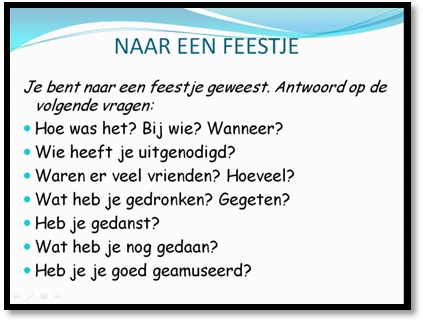
Often, teachers go on using Word for that purpose, not knowing or forgetting that PowerPoint organizes itself beautifully the layout of the text on each screen according its volume as its author is typing in. As the other components of Office, PowerPoint has a global search and replace function as well as a simple grammatical spell checker.
But PowerPoint quickly shows its mnemonic might to people who have learnt it, even superficially. The next screen shot helps the teacher to explain a difficult Dutch spelling feature: the fall of a vowel which is doubled because it is pronounced long [o:] in a one-syllable word when another syllable is added to that word (typically, in the plural or after an –e, for adjectives). Thanks to the animation function, the second “o” falls and the “-len” comes to the left to fill the gap.
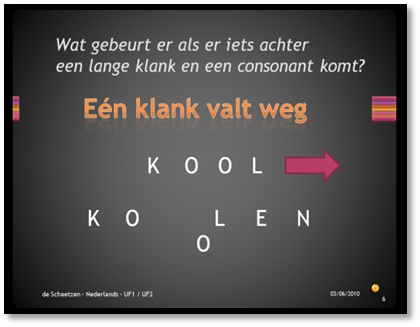
On the following screen only the result of the animation is visible. It is used to show or remind students of the place of the words in inversions (in questions and anteposition of a complement), students see the verb vertrekt go to the first place on the left, with the subject Jan replacing it.
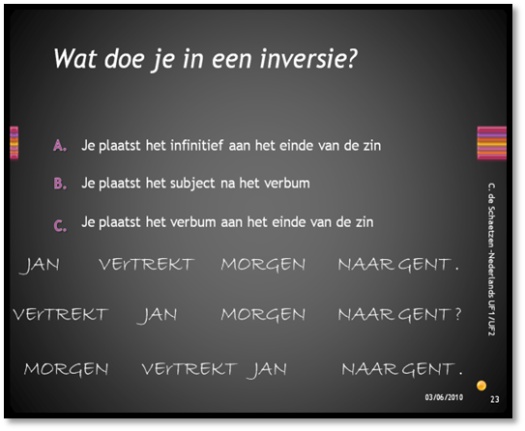
A prominent PowerPoint feature is the sequential display, thanks to which the teacher shows one contents item at a time, according to the reactions of its students, typically: his asking for the meaning of the feeling shown on the drawing. For example, the sentence below, introduces droevig (sad) by a definition (hij huilt: he is crying), together with the absence of –e for predicates. The sentence is only shows at a click!. As for the pre-designed arrow buttons, the teacher has included them in order to quickly jump to the next, preceding, first or last screen of his lesson whenever necessary.
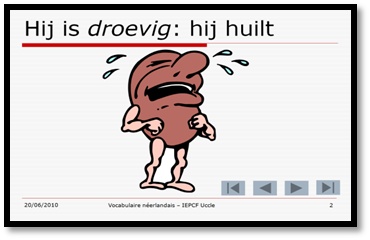
The class or a student working alone is asked a question (Which language do Maroccans speak?). A click! By the teacher shows the answer (Arabisch: arabic). The transition between the different screens and also the path of the different movable items shown on a particular screen can vary. They are numerous, sophisticated and preprogrammed. Here, the letters of the answer come one by one, flickering. This gadgets help sustain the students’ attention, namely in the evening, when they feel a bit tired.
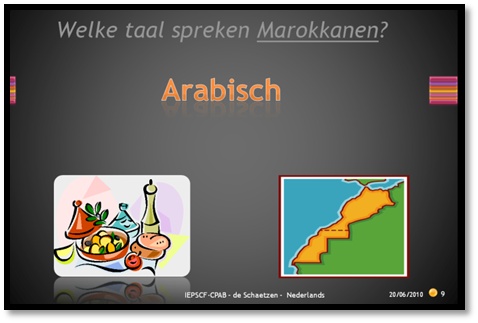
The movement can be lines drawn, one by one, click! by click!, to link to items, like the name of official languages with that of the corresponding nationals (Belgian – French, Dutch and German):
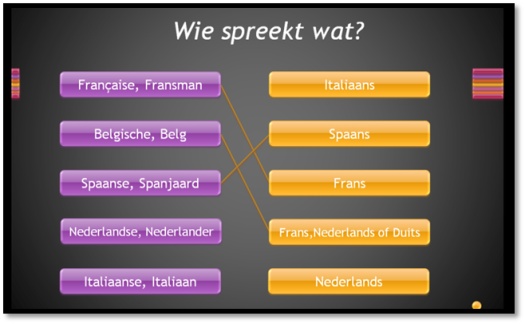
Below, the students first see the drawing, then even lei token (to cook an egg) then the subject (de cook : the cook). A third click ! shows the sentence in the present perfect (de kook heft even lei decoct), after the students have said it in chorus. Both sentences remain thus displayed at the end of the exercise. The rose label comes in a gyratory movement, whereas the sentence to be modified comes slowly upwards, starting from the bottom of the screen. These movements give a lively look to the whole.
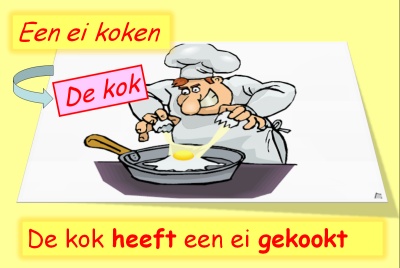
Below, the flags pictured on the soccer balls appear bouncing around on the screen (the question asked is: which ball is not European?).
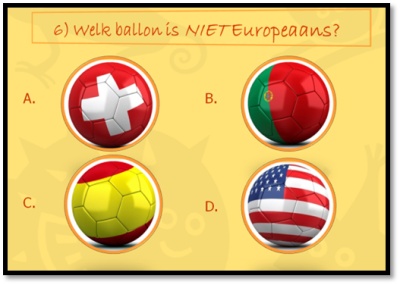
A weather vane rotates, pointing to the four cardinal points (North, west, south and east). The impact of movement and the pleasure, for a class, to react together to a collective stimulus sent from a bright spot in the dark should not be underestimated, according to us…
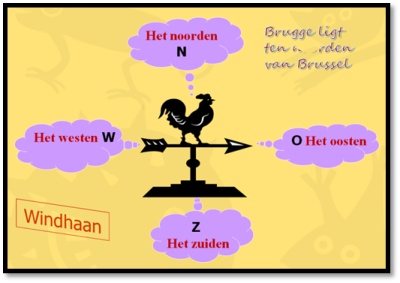
On the next screen shot, the teacher’s click !, let us say after a suggestion by a student, fills the sentence (dit is … tas: this is… bag) with onze (our) ;
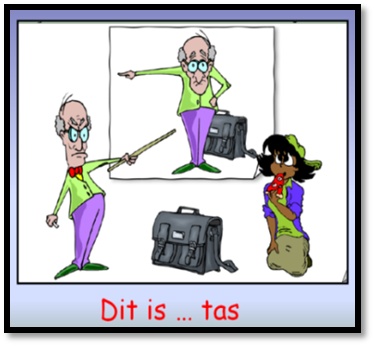
First of all, the different printing functions of PowerPoint enable to print a comic strip and to add to its pictures several types of text bubbles. In the following printed strip, given to beginners, the students are prompted to fill in the bubbles.

The sacrosanct principle according to which a computer should not be used instead of a traditional medium if there is no value added is disputable. First of all, any variation makes students alert and hence, Is valuable as such. Second, multimedia appeals to different intelligence types. So, why not appeal to the students’ eyesight together with their hearing by having them look at a fixed picture while they are listening to some stuff? It helps them to concentrate and they find pictures shining in the dark quite charming.
Below, students see this picture on the screen while hearing a sound track about a travel.
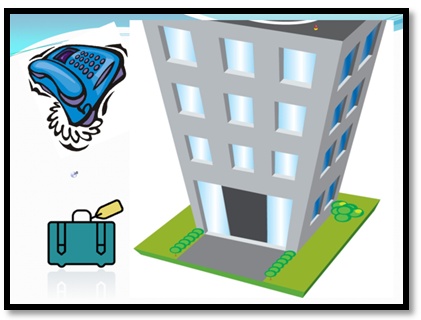
Students then fill in the charts of complaints (vul het tabel van de jurist in) by two tourists to an ombudsman of travel agencies, heard in that sound track and reformulate the reaction of the ombudsman, afterwards, students tell in the present perfect what went wrong during their holidays.
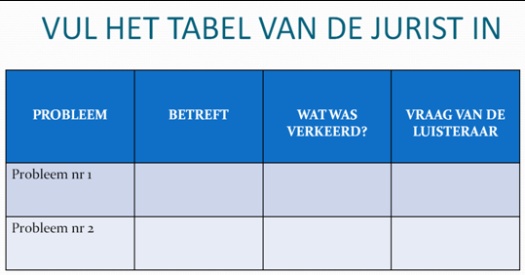
A single picture can also act as a prompt to speaking. Here, the students describe in duos the scenery using a modal (may or might).
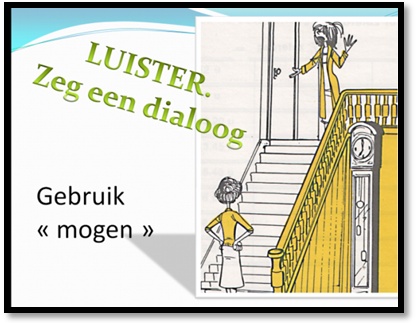
In the audiovisual comics below, the voiced strips helps students to understand. The pictures were scanned and the sequence of their display with the soundtrack was synchronized in PowerPoint. The automatic following up of the slides frees the teacher from pushing buttons. In this strip, a girl tells a boring party to his friend (revision of the present perfect). The pictures of the strip, printed enlarged, plasticized and cut, are sorted in chronological order after the listening.
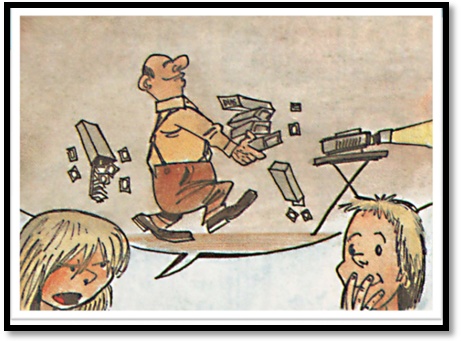
These pictures shows items dealt with in a song that the students hear while its text is subtitled. The listening activity is made easier by reading the text. This is important for Belgian Dutch, for which the material at hand is quite scarce; subtitles facilitate the use of songs by Dutch people, more numerous but with an accent that differs quite strongly from the Flemish one.
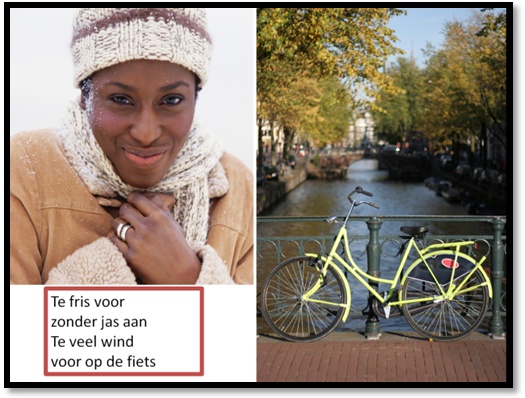
Students listen to a dialogue between a train passenger and a counter clerk, during which they only see two pictures. Then a text is shown. On the following screen, students are asked to find, at home for instance, the question hoe lang duurt de reis?: how long does the travel last?, of which the answer is displayed (de reis duurt een half uur : the journey taks half an hour).
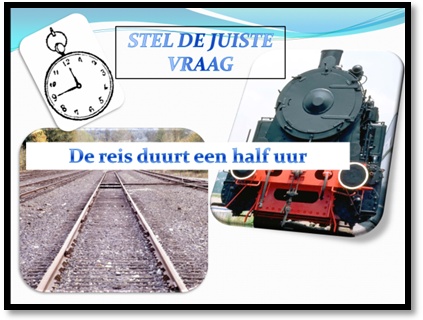
Is it necessary to use dedicated software for all the teaching task which can be computer-aided ? From the 2007 version on, PowerPoint offers with SmartArt, as Word and Excel do, designs to structure mind maps, or, to use the lexical terminology, semantic fields. Below, a group of four displayed one of the rules governing the use of the –e with Dutch adjectives (there is no –e in predicates).

Another group, made of more advanced students, came up with the following diagram in order to explain the complete rule (an adjective takes the –e when it comes immediately before a definite neutral singular noun or before a singular and plural masculine, feminine noun or before a plural neutral noun).
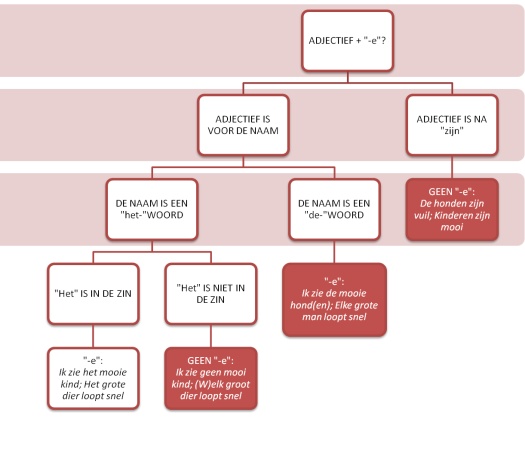
Why go and look for a dedicated package for such a simple choice? Students can be helped in this task by PowerPoint itself, in which the best use of each Venn diagram is explained. For the diagram pre-selected below, the text says it is suited for imbedded concepts and explains how to use it:
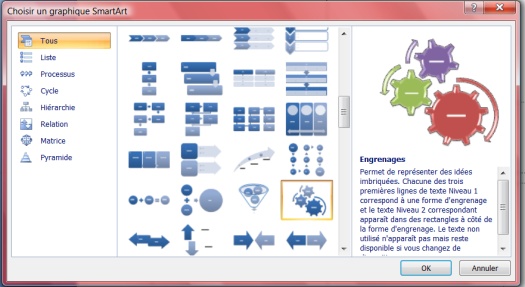
The picture formats readable by PowerPoint are numerous and its last version saves room when storing slides. Thanks to that feature, free-of-right cliparts can be used for kinetic activities. Below, the students are invited to move to the left or the right of the classroom, stating to the sport shoes they prefer (skates or rollers), in order to revise the plural forms.

But free Internet resources comprise complete PowerPoint files. Teachers can use the numerous poetical image sent by friends, for instance slides following each other with a nice music on the background. Students or teachers can add text to these image collections. The screen shots below are instances of the –e in Dutch adjectives (with the help of house walls of Brussels: the tram number crossed out is seventeen), color adjectives (with a collection of shoes: this heel is… ) and a dialogue to buy a train ticket, sequenced by train pictures (op welk perron vertrekt de trein?: on which platform is the train leaving?).
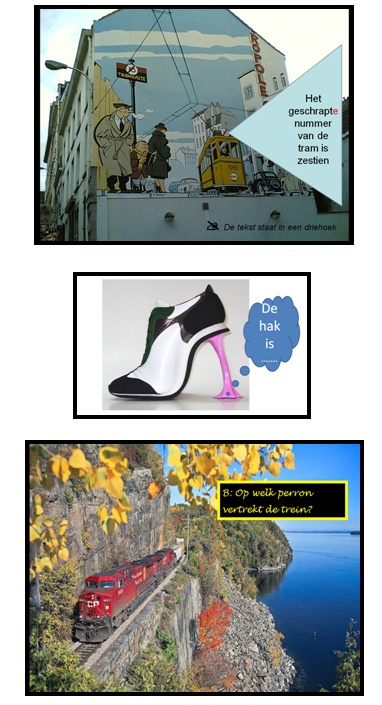
Movies are also available but why show them without any added value? Video clips from YouTube, among other free-of-right sites, can also be subtitled in PowerPoint (below: a man has bought a hot dog):
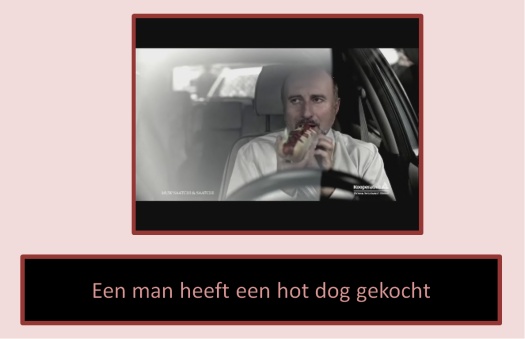
Text can be added in any of the numerous geometric forms available in PowerPoint. Short films shot in public spaces can drill the vocabulary of feelings (on the arrow below: stomverbaasd: astounded).
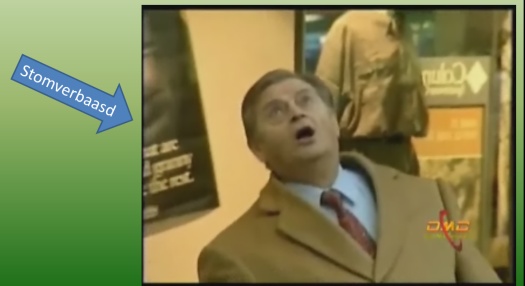
The teacher can also make the students describe the action they are visioning. Below, students use sentence puzzles in the past perfect tense, paying attention to the word order. The film is shown three times in a row without interruption before the story is told. The conversion routine of PowerPoint files into video files in the WMF (Windows Media File) format enable to display all files on any video disc player.
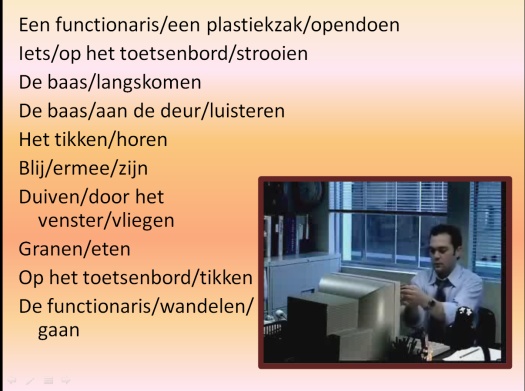
As a matter of fact, PowerPoint is easier to master and use than a word processor. That is the reason why it is the standard communicative tools in companies. It is included in the Windows office software package offered at a discount price to teachers and students. Why not ask students, as homework, to gather and some didactic multimedia files to their peers, instead of dull texts sent by mail? Lots of young adults know the package and have used it in creative ways, for instance for a playful presentation of their friends’ biography, on their wedding. Is this activity not a nice link to the real life of our audience?

Please check the ICT - Using Technology in the Classroom – Level 1 course at Pilgrims website.
Please check the ICT - Using Technology in the Classroom – Level 2 course at Pilgrims website.
Please check the Methodology and Language for Secondary Teachers course at Pilgrims website.


|